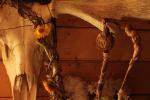so they always say never eat a wild edible unless you can 100 percent identify it, so what if you don't have 100 percent. for me it depends on the family, which is why i like thomas j eppels botany in a day and also the ontario agricultural book publication 505 from the omfra website, what this does it break down the plants into families, so if you learn small things to look for it helps you id the family which makes id allot easier, some plants have no poisionous family memebrs so if you know for example a plant is part of the goosefoot family, but not sure which species it is, me personally i would feel safe to consume it,
dosclaimer-i said me personally- not you






 Reply With Quote
Reply With Quote









Bookmarks